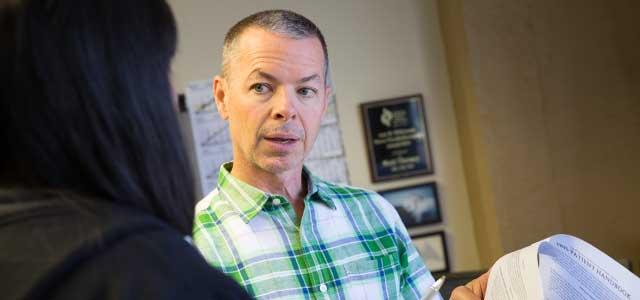
Matt Tierney (photo by Elisabeth Fall)
Pioneering New Strategies for Combating Substance Abuse
The world has long struggled with how to prevent the many social ills associated with people abusing alcohol, prescription medications, heroin, methamphetamine and other drugs.
In the United States, different eras have responded in different ways, though these efforts tend to share a zero-tolerance approach: from Prohibition in the 1920s and early 1930s to the decades-long War on Drugs, including “Just Say No” and the skyrocketing incarceration rates of the 1980s and early 1990s, to ubiquitous 12-step programs.
Yet overdose deaths related to heroin and prescription drugs increased sharply between 2001 and 2013, with the number of deaths from opioid pain relievers tripling during that period, according to the National Institute on Drug Abuse. Binge drinking and drug use contribute to the spread of HIV, with about one in three of the 1.2 million people living with HIV misusing alcohol and drugs. Costs from alcohol- and drug-related health care, crime and lost work productivity amount to about $417 billion a year.
With those statistics in mind, faculty at UC San Francisco School of Nursing are joining a growing number of health experts who are researching strategies that don’t look to zero-tolerance solutions. Rather, these harm reduction strategies accept that people may continue to drink and use drugs, so treatment should focus on helping them use in ways that won’t hurt themselves or others.
Beth Phoenix, health sciences clinical professor and vice chair of the Department of Community Health Systems, says harm reduction eschews the punitive and “moralistic” attitudes that have long kept many people away from treatment.
“There has been so much reliance on a punitive, criminal-justice approach to substance abuse,” says Phoenix, who has taught psychiatric nurse practitioners to screen patients for alcohol and drug abuse that contributes to their anxiety, depression or psychosis. “The result is that we have the highest prison population in the world, and we’ve done almost nothing to reduce drug and alcohol problems.”
Implementing Harm Reduction Strategies
The harm reduction strategies studied by School faculty include pharmacological interventions, behavioral therapy and training health professionals to make substance abuse screening a routine part of health care.
Glenn-Milo Santos, an assistant adjunct professor in the School’s Department of Community Health Systems, is enrolling gay and bisexual men in a National Institutes of Health-funded study that looks at whether a medication called naltrexone, taken on an as-needed basis, can reduce binge drinking.
“Binge drinking is one of the drivers of sexual transmission of HIV, and it’s really prevalent in men who have sex with men,” says Santos.
His “Say When” study departs from the “Just Say No” message of a previous era. The Say When study won’t tell these men they should stop going out to clubs, drinking or having sex. Rather, the study wants to see if letting these men take naltrexone before they go out will prevent binge drinking (defined as consuming five or more drinks on one occasion) and reduce alcohol-associated sexual risk behaviors.
The low-cost, FDA-approved drug is known to reduce cravings and block alcohol’s rewarding effects. It’s typically prescribed for daily use to “alcohol-dependent” people to help them maintain abstinence. Santos’ study is trying to expand the population that can benefit from naltrexone by focusing on men who aren’t dependent and instructing them they only need to take it when they believe they need it.
“One of the difficult things in reaching people is that they don’t want to be pathologized; they don’t want to be put into that category of being told they have a problem if they don’t,” Santos says. “We’re not saying, ‘You have a problem.’ We’re saying, ‘We’re interested in helping support you in your goal, whether it’s cutting down or stopping.”
The idea of working with patients to identify their own treatment goals encapsulates the “meet people where they are” ethos of harm reduction, Santos says.
The Case for Harm Reduction
Harm reduction has its roots in the needle-exchange and safe-sex campaigns that emerged in the early years of the AIDS epidemic.
It remains controversial, despite growing evidence that it offers a practical and effective approach to addressing substance abuse disorders, says Matt Tierney, a psychiatric nurse practitioner at San Francisco General Hospital and School volunteer faculty member, who works with people who abuse prescription drugs, heroin and other opioids.
A 2008 report from the United Nations Office on Drugs and Crime said harm reduction should be part of any comprehensive approach to reverse the adverse health and social consequences of substance abuse.
Notably, harm reduction is gaining acceptance as a treatment approach for alcohol abuse. This concept may be the most controversial of all, considering that the abstinence-based principles of the 12 steps originated with Alcoholics Anonymous (AA). The 12 steps have since become a mainstay of treatment for various substance abuse and behavioral disorders, including sex addiction and compulsive gambling.
“For most of the 20th century, the 12 steps have been the only game in town. And no doubt, AA and NA [Narcotics Anonymous] have saved countless lives,” says Tierney.
Still, studies show that the 12 steps don’t work for everyone and other interventions, such as cognitive behavioral therapy, work just as well.
Moreover, there is some concern that the treatment industry’s emphasis on the 12 steps may discourage some people from seeking help. The majority of the 17 million Americans with drinking problems go untreated, according to the National Institute on Alcohol Abuse and Alcoholism. Those kinds of numbers prompted a 2002 editorial in Addiction saying that harm reduction can make treatment “more accessible and engaging to an array of individuals.”
Keeping People in Treatment
Tierney says harm reduction can reach people before their alcohol or drug use gets out of hand, and it can keep people in treatment so they don’t suffer life-threatening relapses.
His most recent study looks at whether people with opioid use disorders will remain in treatment if they received prescribed buprenorphine plus adjunctive therapeutic services that might include individual and group counseling, medication support services, education and nurse case management. The drug is FDA-approved for the treatment of opioid use disorders, and helps treat opioid withdrawal and cravings.
“We counsel prediabetics on how to eat better and exercise, and we do harm reduction education with people with borderline hypertension. We don’t want to wait until people hit bottom before they can get treatment,” says Tierney.
Talk Therapy’s Potential
Adam Carrico, an assistant professor in the Department of Community Health Systems, has spent much of his career working with HIV-positive gay and bisexual men who also use methamphetamine.
As with Santos’ clients, Carrico’s study participants are open to “changing their relationship” to methamphetamine and other substances, but many do not begin with abstinence as a goal.
Last year he completed a study with the Stonewall Project at the San Francisco AIDS Foundation on using harm reduction-based cognitive behavioral therapy to help men become receptive to learning how to stay safe while using methamphetamines and having sex. Carrico found that the 211 men in this study cut back on the amount of drugs they used and engaged in fewer high-risk sexual encounters while high.
 Adam Carrico, Carol Dawson-Rose “We want people to talk about all of these things they can do to be safe before they’re high and in the moment,” he says.
Adam Carrico, Carol Dawson-Rose “We want people to talk about all of these things they can do to be safe before they’re high and in the moment,” he says.
“Normalizing” Substance Abuse Treatment
Carol Dawson-Rose, a professor in the Department of Community Health Systems, has worked with drug and alcohol users since the 1990s and says they often face discrimination in health care settings.
This discrimination may stem from providers’ lack of training or personal biases against people who have difficulty controlling their use. “There’s a lot of baggage around this issue,” she says. “Patients don’t always get listened to, and they don’t always receive the help they need.”
She is participating in a new national initiative launched by the Substance Abuse and Mental Health Services Administration (SAMHSA) to educate providers about substance use and train them to intervene early. (SAMHSA also recently awarded $1.4 million to the department to develop and implement substance abuse and mental health treatment in partnership with Larkin Street Youth Services.)
Screening, Brief Intervention, and Referral to Treatment (SBIRT) aims to make screening for drug and alcohol abuse a routine part of preventive care – just like screening for heart disease or cancer. SAMHSA has funded training in primary care centers, hospital emergency rooms and community clinics nationwide.
Dawson-Rose is working to integrate SBIRT into the curricula for master’s degree students at the School. She also trains nurses and medical residents at San Francisco General Hospital and behaviorists at San Francisco Department of Public Health primary care clinics.
“What we’re trying to do with this curriculum is normalize substance abuse treatment into preventive care,” she says.
SBIRT also teaches nurses and doctors to use motivational interviewing to gauge the severity of a patient’s problem and identify the appropriate level of treatment. For example, after a nurse learns a patient uses cocaine, he can then engage her in a conversation about the pros and cons of using.
“Patients don’t mind being asked,” she says. “We’re trying to help people be more reflective about their use and think about whether this is an issue that they think we can help them with.”
Dawson-Rose understands that harm reduction gets “a bad rap” from those who believe it gives people permission to keep abusing alcohol and drugs. The reality is that patients won’t cut back or quit until they are ready. Hearing a “just say no” message from a provider can end the conversation.
Harm reduction also recognizes that it’s difficult for people to change, especially when it means giving up routines that may offer short-term pleasure or relief, she says. “If someone is diagnosed with diabetes and told, ‘This is the diet you need to stick to,’ what’s the likelihood that they will completely change their behavior after they walk out the door?” Dawson-Rose asks.
But a nonjudgmental approach that’s willing to meet people where they are at least keeps the dialogue going, she says. And therein lies the potential for change.



